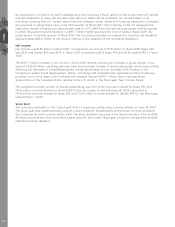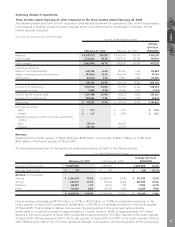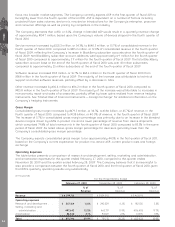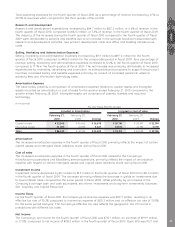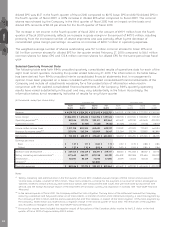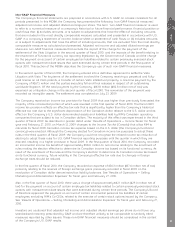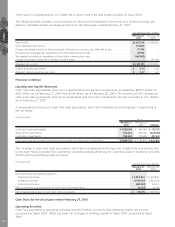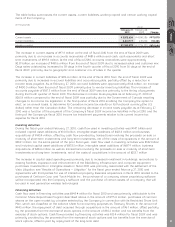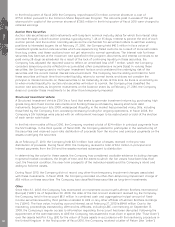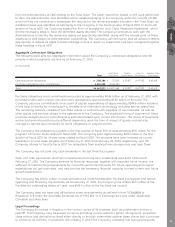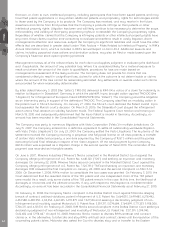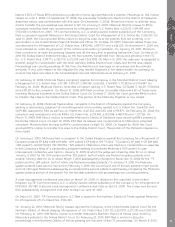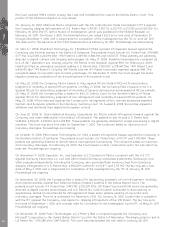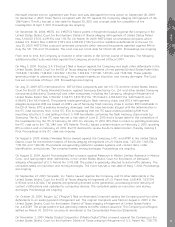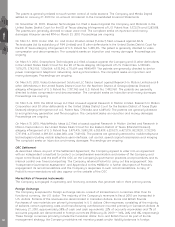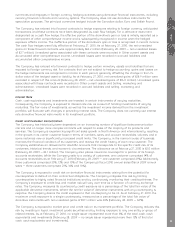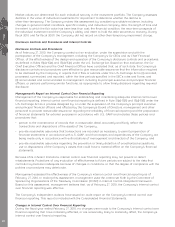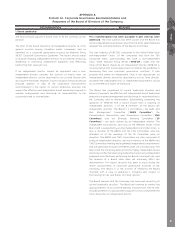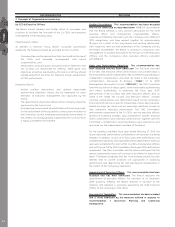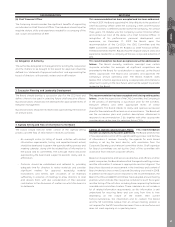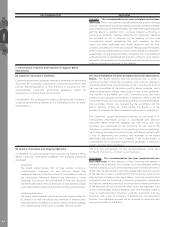Blackberry 2010 Annual Report Download - page 42
Download and view the complete annual report
Please find page 42 of the 2010 Blackberry annual report below. You can navigate through the pages in the report by either clicking on the pages listed below, or by using the keyword search tool below to find specific information within the annual report.
that own, or claim to own, intellectual property, including participants that have been issued patents and may
have filed patent applications or may obtain additional patents and proprietary rights for technologies similar
to those used by the Company in its products. The Company has received, and may receive in the future,
assertions and claims from third parties that the Company’s products infringe on their patents or other
intellectual property rights. Litigation has been and will likely continue to be necessary to determine the scope,
enforceability and validity of third-party proprietary rights or to establish the Company’s proprietary rights.
Regardless of whether claims that the Company is infringing patents or other intellectual property rights have
any merit, those claims could be time-consuming to evaluate and defend, result in costly litigation, divert
management’s attention and resources, subject the Company to significant liabilities and could have the other
effects that are described in greater detail under “Risk Factors — Risks Related to Intellectual Property” in RIM’s
Annual Information Form, which is included in RIM’s Annual Report on Form 40-F. Additional lawsuits and
claims, including purported class actions and derivative actions, may also be filed or made based upon the
Company’s historical stock option granting practices.
Management reviews all of the relevant facts for each claim and applies judgment in evaluating the likelihood
and, if applicable, the amount of any potential loss. Where it is considered likely for a material exposure to
result and where the amount of the claim is quantifiable, provisions for loss are made based on
management’s assessment of the likely outcome. The Company does not provide for claims that are
considered unlikely to result in a significant loss, claims for which the outcome is not determinable or claims
where the amount of the loss cannot be reasonably estimated. Any settlements or awards under such claims
are provided for when reasonably determinable.
By letter dated February 3, 2005 (the “Letter”), TMO-DG delivered to RIM-UK a notice of a claim for indemnity in
relation to litigation in Du
¨sseldorf, Germany in which the plaintiff, Inpro, brought action against TMO-DG (the
“Litigation”) for infringement of European Patent EP0892947B1 (the “Patent”). The Company joined the Litigation
as an intervening party in support of the defendant TMO-DG. The Company also filed an invalidity action in
the patent court in Munich Germany. On January 27, 2006, the Munich court declared the Patent invalid. Inpro
had appealed the Munich court’s decision. On March 21, 2006, the Du
¨sseldorf court stayed the infringement
action until a final decision on validity has been made. The Federal Supreme Court held an oral hearing on
March 18, 2010 and subsequently determined that the Inpro Patent is invalid in Germany. Accordingly, no
amount has been recorded in the Consolidated Financial Statements.
The Company was party to numerous litigations with Visto Corporation (“Visto”) in multiple jurisdictions. On
July 15, 2009, the Company entered into a definitive agreement to settle all outstanding worldwide litigation
with Visto (“Visto Litigations”). On July 23, 2009, the Company settled the Visto Litigations. The key terms of the
settlement involved the Company receiving a perpetual and fully-paid license on all Visto patents, a transfer
of certain Visto intellectual property, a one-time payment by the Company of $267.5 million and the parties
executing full and final releases in respect of the Visto Litigation. Of the total payment by the Company,
$163.8 million was expensed as a litigation charge in the second quarter of fiscal 2010. The remainder of the
payment was recorded as intangible assets.
On June 6, 2007, Minerva Industries (“Minerva”) filed a complaint in the Marshall District Court against the
Company alleging infringement of U.S. Patent No. 6,681,120 (“’120”) and seeking an injunction and monetary
damages. On January 22, 2008, Minerva filed a second complaint in the Marshall District Court against the
Company alleging infringement of U.S. Patent No. 7,321,783 (“’783”) and seeking an injunction and monetary
damages. RIM answered the first Complaint on January 28, 2008 and the second Complaint on March 14,
2008. On December 1, 2008, RIM’s motion to consolidate the two cases was granted. On February 3, 2010, the
Court determined that the asserted claims of the ‘120 patent and one independent claim of the ‘783 patent
were invalid. As a result, only some claims of the ‘783 patent remain in the case. At this time, the likelihood of
damages or recoveries and the ultimate amounts, if any, with respect to this litigation is not determinable.
Accordingly, no amount has been recorded in the Consolidated Financial Statements as at February 27, 2010.
On February 16, 2008, the Company filed a complaint in the Dallas District Court against Motorola alleging
breach of contract, antitrust violations, patent infringement of U.S. Patent No. 5,664,055; 5,699,485; 6,278,442;
6,452,588; 6,489,950; 6,611,254, 6,661,255; 6,919,879 and 7,227,536 and seeking a declaratory judgment of non-
infringement and invalidity against Motorola U.S. Patent Nos. 5,359,317; 5,074,684; 5,764,899; 5,771,353; 5,958,006;
5,706,211 and 6,101,531. On February 21, 2008, RIM filed a second complaint in the Dallas District Court seeking a
declaratory judgment of non-infringement and invalidity of Motorola U.S. Patent No. 5,157,391; 5,394,140;
5,612,682 and 5,974,447. On April 10, 2008, Motorola filed a motion to dismiss RIM’s antitrust and contract
claims or, in the alternative, to bifurcate and stay RIM’s antitrust and contract claims until the resolution of the
co-pending patent claims. Motorola also asked the Court to dismiss, stay and or transfer to the Eastern
MD&A
34


